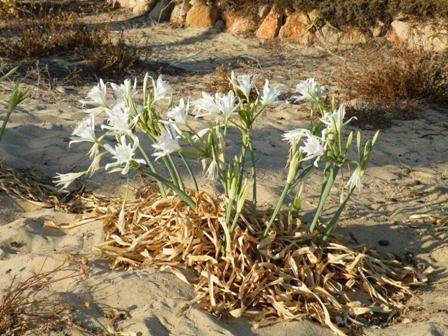At One with Nature - Summer Show offs
Sue Parker admires outstanding qualities of some late developers
Based on an article by Sue Parker in Algarve Resident, July 2015. Algarve Resident is the leading English-language newspaper and the source of essential information for Residents and would-be Residents in the Algarve. More information about Algarve Resident...
The period between December and the end of May is my favourite time to be in the Algarve. The protracted spring, which begins with early flowering plants such as Friar’s Cowl Arisarum vulgare (an Algarve Christmas gift), Common Asphodel Asphodelus aestivus, and Almond blossom before exploding into a wildflower wonder world in March and April, is one of the marvels of the natural world that we who live, work and play in the Algarve are privileged to experience.

The Spanish Oyster Plant - Scolymus hispanicus
The prospect of ‘eternal summer’ is what attracts many of us to uproot ourselves from chillier northern climes and move south. It is not long, however, before we become aware that the Algarve has seasons just like anywhere else – warmer and dryer than most, but no less distinctive for that. General wildlife enthusiasts get much more out of the natural year in the Algarve than do ‘wildflower extremists’, who might happily fast-forward through the parched months of summer to the autumn. That’s when the fungal world wakes up and stimulates renewed interest in things found on the ground that will serve as distraction therapy until spring delivers the next flower fix. Such a prejudice against summer can mean missing several real gems, so put on the sunhat and sun cream and get out there to see some summer sensations. These plants range from the blindingly obvious to the very hard to find, but they are there and well worth the effort of the search.
One tough plant that can survive everything that high summer can throw at it is the Spanish Oyster Plant Scolymus hispanicus, and to prove the point it grows in some truly inhospitable spots too. It’s very hard to miss and often grows up to two metres in height, with long straggly stems bearing bright yellow flowers and vibrant green leaves, in sharp contrast to most other plants around that by now have become scorched and brown. This member of the Daisy family differs from its benign relatives such as the Crown Daisies which are so common in the Algarve; it has very sharp spines and should be admired from a safe distance.

Sea Daffodil - Pancratium maritimum
Another common high summer beauty which seems to be indestructible is the Sea Daffodil Pancratium maritimum. Growing in perhaps the toughest environment the region has to offer, this glorious flower thrives on salty beaches despite the high footfall of visitors in summer and the cold windy conditions in winter when only its dark strap-like leaves and a scattering of large black seeds are visible. The plant emerges from a deeply buried bulb, and the showy pure white flowers grow in clusters of 3 to 15. Blooming from July onwards, Sea daffodil delights summer visitors who, never having witnessed our spring flower bonanza, might otherwise imagine the Algarve to be a flower-free zone.
Spanish Oyster Plant and Sea Daffodil are not difficult to find, but for those who fancy a real challenge there is a very special plant that flowers in summertime in the Algarve – Summer Lady’s-tresses Spiranthes aestivalis. This rare, pure white wild orchid is already extinct in Britain, Holland and Belgium and is in steep decline throughout its range due to habitat destruction. Very few people, including me, have been lucky enough to find this orchid in the Algarve but it is known from a few spots in the Caldas de Monchique area. Like its close relative Autumn Lady’s-tresses, which we are also lucky enough to have here, Summer Lady’s-tresses lives in humid conditions, and agricultural land drainage has been its downfall.

Summer Lady's-tresses - Spiranthes aestivalis - is protected throughout Europe
To the uninitiated Summer Lady’s-tresses and Autumn Lady’s-tresses (which flowers next to the Quarteira River near Paderne) look remarkably similar, but unlike many other orchids which can be easily confused with each other and which flower at the same time, these two have flowering times separated by several months. Summer Lady’s-tresses flowers during June and July, whereas Autumn Lady’s-tresses cunningly awaits the start of the autumn rains and pops up in October and November. In terms of accurate identification of these two species, therefore, timing really is everything!
Summer Lady’s-tresses are reported from Germany in the north to as far south as North Africa. It also extends its range eastwards as far as the Balkans. So precariously poised is the survival of this enigmatic orchid, that even our tiny populations in the Algarve are of huge significance in terms of its continued existence. If you are lucky enough to stumble across this delightful little plant please don’t pick the flowers or dig up the plants – they are useless as cut flowers and never, ever recover from being moved to gardens. Simply take its picture and then leave it to continue fighting its battle for life – this patient is critical!

